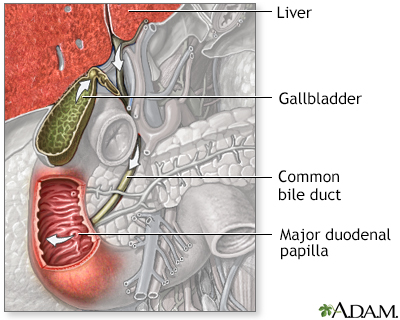Pregnancy SmartSiteTM
Bile duct cancer DefinitionCholangiocarcinoma (CCA) is a rare cancerous (malignant) growth in one of the ducts that carries bile from the liver to the small intestine. CausesThe exact cause of CCA isn't known. However, many of these tumors are already quite advanced by the time they are found. CCA may start anywhere along the bile ducts. These tumors block off the bile ducts. Both men and women are affected. Most people are older than 65. People with the following health problems may have a higher chance of developing CCA:
SymptomsSymptoms of CCA may include any of the following:
Exams and TestsYour health care provider will perform a physical exam. Tests will be done to check for a tumor or blockage in the bile duct. These may include:
Blood tests that may be done include:
TreatmentThe goal is to treat the cancer and the blockage it causes. When possible, surgery to remove the tumor is the treatment of choice and may result in a cure. Often the cancer has already spread locally or to another area of the body by the time it is diagnosed. As a result, surgery to cure the cancer is not possible. Chemotherapy or radiation may be given after surgery to decrease the risk of the cancer returning. In select cases, a liver transplant can be tried. Endoscopic therapy with stent placement can temporarily relieve blockages in the biliary ducts. This may also relieve jaundice when the tumor cannot be removed. Outlook (Prognosis)Completely removing the tumor allows some people to survive with the possibility of complete cure. The survival time varies greatly from several months to several years. Outlook depends on:
If the tumor cannot be completely removed, a cure is generally not possible. With treatment, about one half of affected people live a year, and about one half live longer, but rarely beyond 5 years. You and your family may want to start thinking about end-of-life planning, such as:
Possible ComplicationsComplications of CCA include:
When to Contact a Medical ProfessionalCall your provider if you have jaundice or other symptoms of cholangiocarcinoma. ReferencesGibson RN, Sutherland TR. The biliary system. In: Adam A, Dixon AK, Gillard JH, Schaefer-Prokop CM, eds. Grainger & Allison's Diagnostic Radiology. 7th ed. Philadelphia, PA: Elsevier; 2021:chap 24. National Cancer Institute website. Bile duct cancer (cholangiocarcinoma) treatment (PDQ) -- health professional version. www.cancer.gov/types/liver/hp/bile-duct-treatment-pdq. Updated June 2, 2022. Accessed June 24, 2022. Rajkomar K, Koea JB. Intrahepatic cholangiocarcinoma. In: Jarnagin WR, ed. Blumgart's Surgery of the Liver, Biliary Tract and Pancreas. 6th ed. Philadelphia, PA: Elsevier; 2017:chap 50. Rizvi SH, Gores GJ. Tumors of the bile ducts, gallbladder, and ampulla. In: Feldman M, Friedman LS, Brandt LJ, eds. Sleisenger and Fordtran's Gastrointestinal and Liver Disease. 11th ed. Philadelphia, PA: Elsevier; 2021:chap 69. | |
| |
Review Date: 4/29/2022 Reviewed By: Todd Gersten, MD, Hematology/Oncology, Florida Cancer Specialists & Research Institute, Wellington, FL. Review provided by VeriMed Healthcare Network. Also reviewed by David C. Dugdale, MD, Medical Director, Brenda Conaway, Editorial Director, and the A.D.A.M. Editorial team. The information provided herein should not be used during any medical emergency or for the diagnosis or treatment of any medical condition. A licensed medical professional should be consulted for diagnosis and treatment of any and all medical conditions. Links to other sites are provided for information only -- they do not constitute endorsements of those other sites. No warranty of any kind, either expressed or implied, is made as to the accuracy, reliability, timeliness, or correctness of any translations made by a third-party service of the information provided herein into any other language. © 1997- A.D.A.M., a business unit of Ebix, Inc. Any duplication or distribution of the information contained herein is strictly prohibited. | |

 Digestive system
Digestive system Bile pathway
Bile pathway
